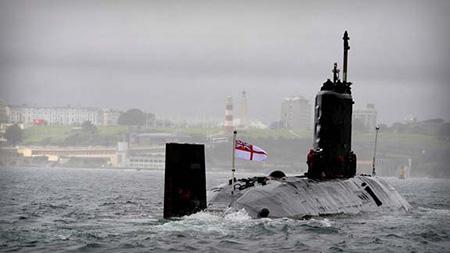The unit was launched in 1988, and is a 5.300 ton nuclear-powered 'hunter-killer' submarine. Its function is that of hunting enemy boats for the denial of British territorial waters and has anti-ship capabilities and ground attack with Tomahawk cruise missiles.
The damage suffered, estimated at 500.000 £, was officially reported by an accidental collision with a sheet of floating ice during surfacing. The British technicians believe this justification to be plausible, which in any case required the re-entry of the submerged unit because the anechoic tiles covering the surface of the submarine have been damaged, indispensable for guaranteeing the quietness of the vehicle.
.jpg) The emergence is one of the most delicate moments in the operations of a submerged unit, but what remains to be ascertained is the reason why the commander would have ordered this maneuver. The mission of a hunter killer is to navigate in silent attitude in search of hostile contacts in the quadrant to which he has been assigned for patrolling, therefore it could be an emergency emergence such as to risk a collision with the ice above and certainly not of an exercise, again for reasons of silence. But this hypothesis would imply a very serious event. The other cause that remains valid is the collision with a Russian submarine.
The emergence is one of the most delicate moments in the operations of a submerged unit, but what remains to be ascertained is the reason why the commander would have ordered this maneuver. The mission of a hunter killer is to navigate in silent attitude in search of hostile contacts in the quadrant to which he has been assigned for patrolling, therefore it could be an emergency emergence such as to risk a collision with the ice above and certainly not of an exercise, again for reasons of silence. But this hypothesis would imply a very serious event. The other cause that remains valid is the collision with a Russian submarine.
The Royal Navy, in order to conceal the truth about accidents to its units, had already resorted to similar explanations during the cold war, damages that then turned out to be collisions with Russian boats engaged in patrols and data acquisition missions: In 1981, to the crew of HMS Scepter, they were ordered to testify that they had hit an iceberg, but in reality an impact had occurred with the Russian submarine K-211.
In 2009, another incident occurred to a British vessel, the Hms Vanguard, which collided with the French Triomphant. The silence of these vehicles is such that they can approach each other without being detected by the sonar apparatuses, and where the commander of the pursued submarine decides a rapid approach, the speed of the pursuing vehicle does not allow an evasive maneuver and this generates accidental collisions.
The incident dates back to a year ago, according to official statements, but the HMS Talent has been photographed for a few days while returning to the port of Plymouth with a damaged sail.
Giovanni Caprara
Source: Daily Mail












